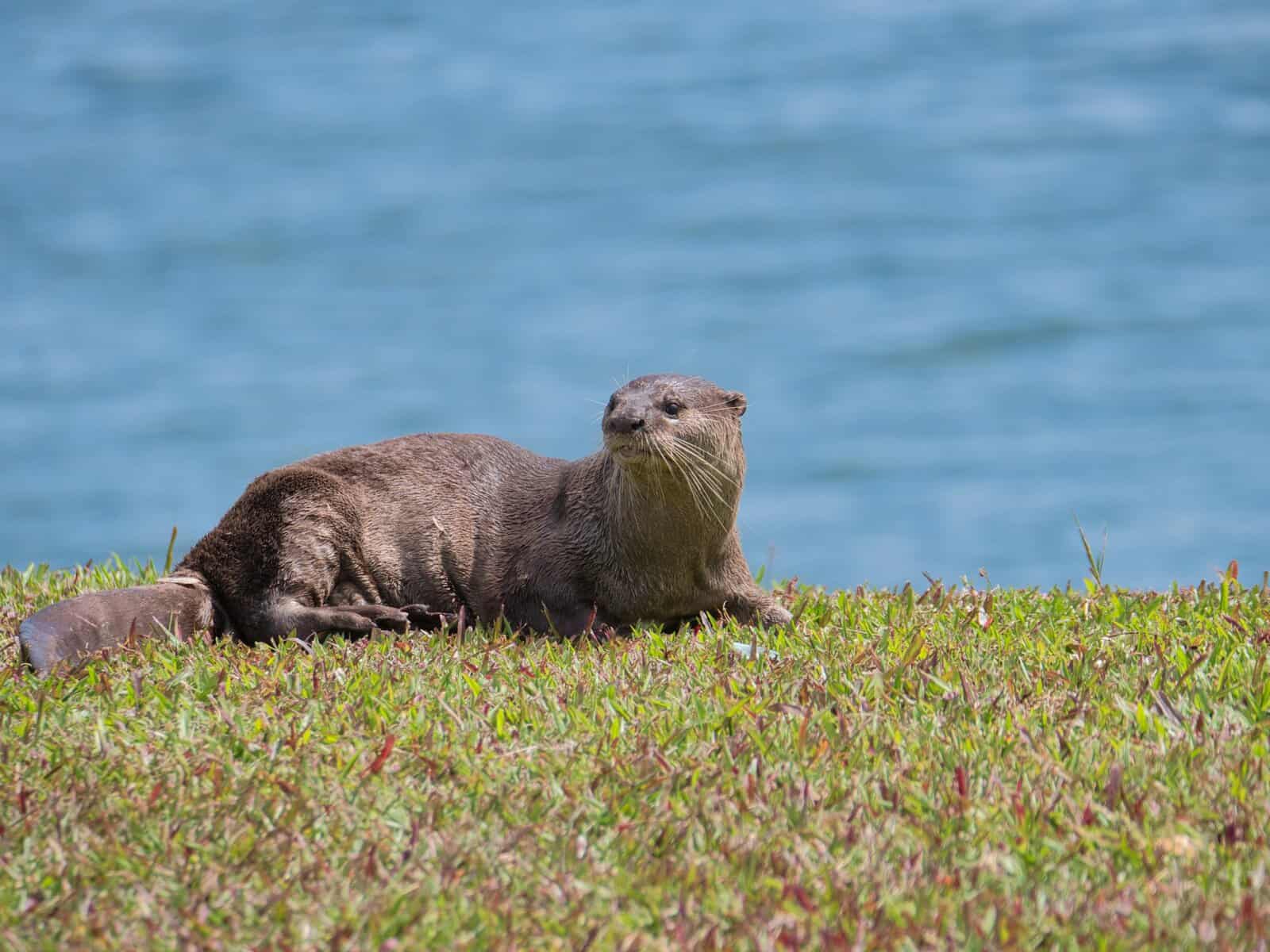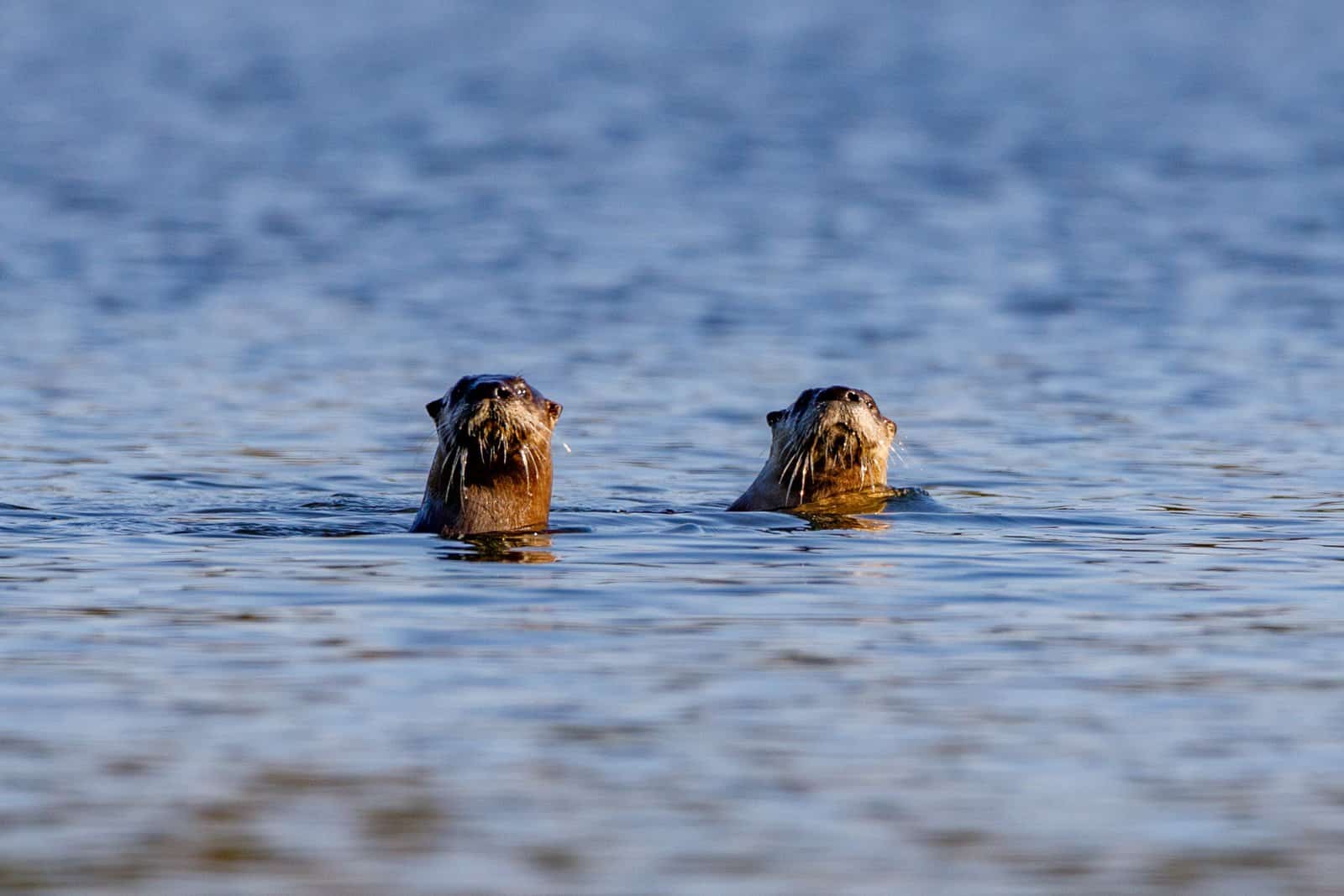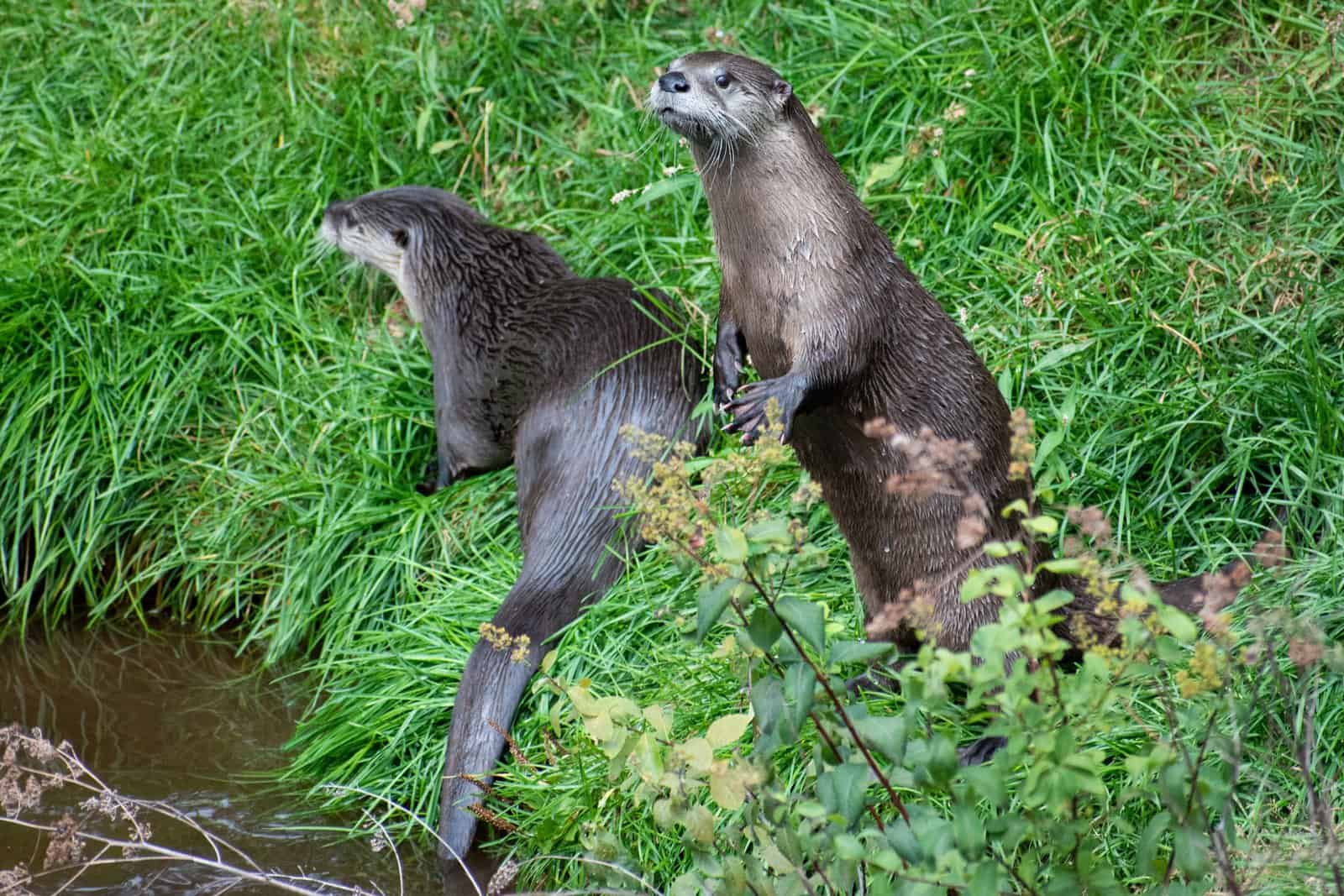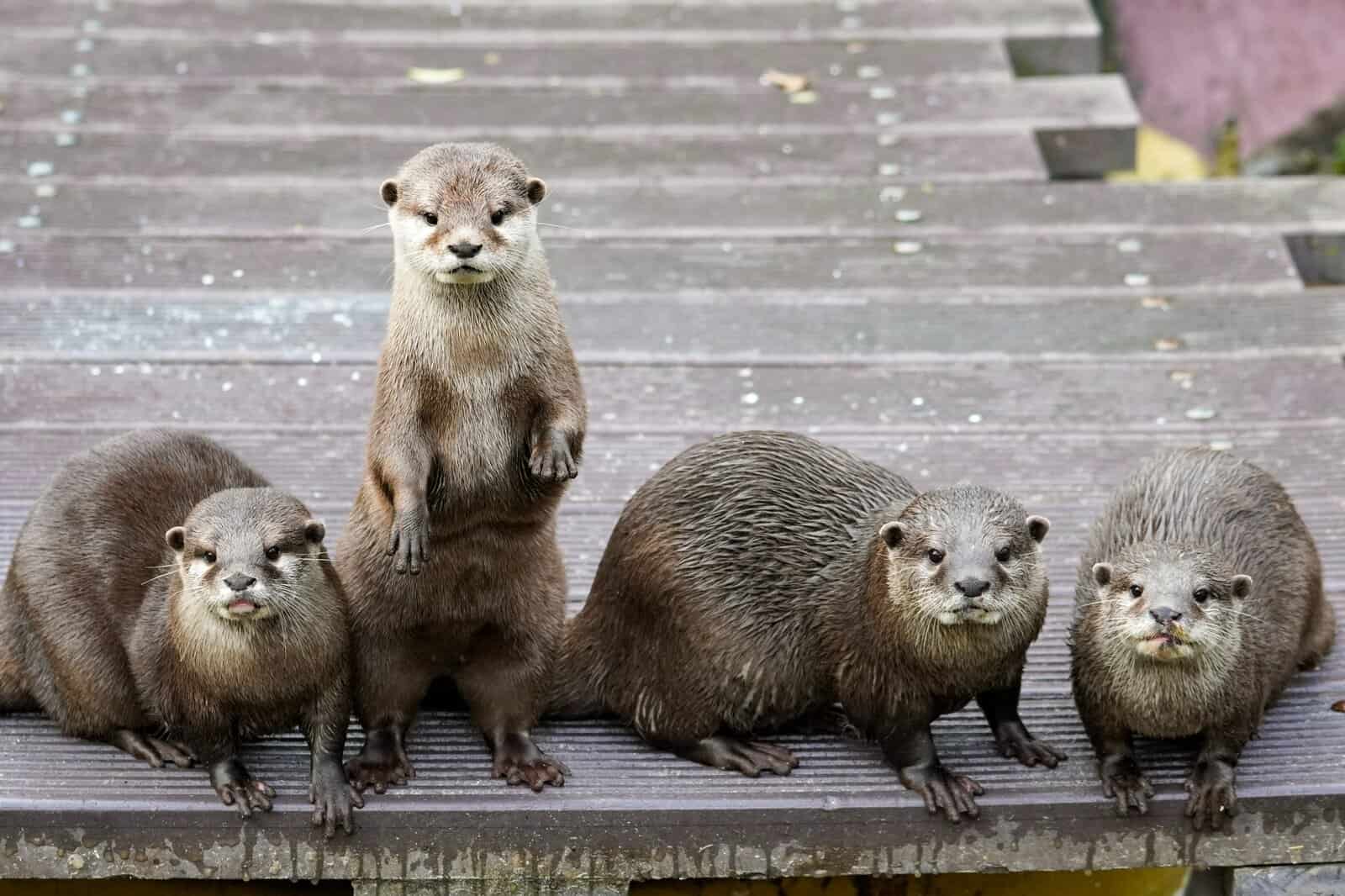
10 Surprising Differences Between River Otters and Sea Otters
Otter belongs to the family of gametophytes, under the order of carnivores that fall under the class Mammalia, under the phylum Chordata, which belongs to the animal kingdom.

The family of gametes includes otters, weasels, minks, badgers, and marmots. As for otters, s they are small to medium-sized animals with short legs, long and slender bodies, and long, tapering tails. Their bodies, except for the feet and snout, are covered with soft fur. They are distinguished by their developed senses and sharp instincts that help them hunt. They are semi-aquatic animals that get their food from water, and they can live in marine and freshwater environments.
Otter Species
There are 13 species of 7 genera spread worldwide except Antarctica: otter, spotted-necked, periodic, New World otter, wing-tailed, small-clawed, and sea otter.
Lutra includes the following species:
1. European Otter: (scientific name Lutra Lutra)
The European or Eurasian otter lives in freshwater, and in some cases, it may reach the sea in search of food. Still, it quickly washes the salt off its body when it returns to fresh water, and it is the most common type, as it spreads in parts of Asia, Africa, and throughout Europe. The European otter is nocturnal in general and loves isolation. Still, it may live in a family, and its diet consists of fish, crustaceans, amphibians, reptiles, birds, eggs, insects, and worms.
2. Hairy-nosed otter: (scientific name Lutra sumatrana)
The main characteristics of the hairy nosed are the abundant hair in its nostrils and a white upper lip. Its diet consists mainly of fish, and it eats frogs, lizards, swamp turtles, water snakes, crustaceans, and insects that live in swamps and shallow coastal waters. The hairy nosed that live in Southeast Asia are a rare and endangered species.
Many dangers threaten it within the limits of its natural environment, so it is now preserved and multiplied under the supervision of humans outside the scope of its environment until its numbers stabilise and it becomes possible to transfer it to natural reserves.

3. Spotted-necked Otter
It includes one species, also called Spotted-necked, or Speckle-throated, scientifically known as Hydrictis maculicollis. The individuals of this species are spread throughout Africa, specifically south of the Sahara Desert. Despite the wide geographical range that constitutes the limits of its environment, the numbers of individuals of this species are very few.
Due to the increase in the rate of pollution and the loss of the habitats in which it lives, and because it is very demanding regarding the environment suitable for its living, it lives only in areas where fresh water is available throughout the year,
It does not live in marine or coastal environments that contain salty water. On the other hand, its areas must include dense vegetation because it provides a cover that protects them from predators during rest and gives him a safe place to build dens, which are usually equipped with an entrance that can be accessed from under the water.
4. Periodic Otter
The periodic or (Lutrogale) includes one species, the smooth-coated, scientifically known as (Lutrogale Perspicillata). Individuals of this species spread throughout South Asia and Southeast Asia. Their presence has been confirmed in Pakistan, India, Nepal, Bhutan, Bangladesh, southwest China, Myanmar, Thailand, Vietnam, Malaysia, Indonesia and Brunei. As for the Middle East, they only exist in Iraq, where individuals of this species existed as a partial community.
Although soft-furred live mainly in the plains, they can also live in semi-arid regions in northwestern India and the Deccan Plateau. Peat, mangrove forests, and rice fields in search of food.
5. New World otters
The New World otter (Lontra) includes the following species:
- Northern River Otter: (scientific name Lontra Canadensis),
Northern river otters are adapted to live in semi-aquatic habitats in Canada and the United States except for parts of the southwest and in Mexico in the Rio Grande and Delta regions. Colorado River and this type can grow and live in ponds, swamps, lakes, rivers, and estuaries found in cold or warm areas as long as they can find enough food.
Other than these places, they prefer to live in lakes and the swampy lakes that contain abandoned burrows for other mammals, such as the American beaver, to use as a place to live, and these animals avoid bodies of water with sloping beaches consisting of sand and pebbles.
- Southern River Otter: (scientific name Lontra provocax)
The southern river otter lives permanently near fresh water, as it lives near rivers whose banks contain vegetation, in inland lakes, and near the rocky coastal areas of both Argentina and Chile. Its diet consists mainly of fish. Still, it also hunts crabs, molluscs, and birds.
Among the problems that faced this species of southern rivers are overfishing and loss of habitat, which led to a decline in their numbers.
- Neotropical River Otter: (scientific name Lontra longicaudis)
The neotropical river otter is also known as the long-tailed. The length of its tail may be equal to the size of its body or longer than it. Individuals of this species live in all parts of South America except for Chile and highly arid regions, where its range extends from Mexico south to northern Argentina, and prefers to live in warm temperate climates, rainforests, evergreen forests, rocky beaches, and coasts. It needs to be constantly present near salt and fresh water, where he spends most of his time inside the water.

- Marine otter: (Scientific name Lontra Felina)
The Marine Otter lives along the Pacific coast extending from northern Peru towards the south through the coast of Chile to southern South America, in addition to some isolated areas in Argentina. The sea otter is distinguished from the rest of the New World otters genus in that it lives exclusively in the seas, cannot live in freshwater, and prefers areas with strong winds and dense seas that contain many types of rocky fish, molluscs, and crustaceans.
The Marine ones spend most of their time in the water, but sometimes they may resort to caves with rocky outcrops, especially during the breeding season. As it provides him protection from predators and contains much prey, it is believed that sea otters do not live on the Atlantic coasts of Patagonia because its beaches are sandy, and they prefer rocky shores in particular.
Pteronura
The Pteronura, characterised by a flat, wing-like tail, includes one species, the Giant Otter, known scientifically as (Pteronura Brasiliensis), which is known to be the largest species of water otter. Still, hunting operations have turned it into an animal close to extinction, with a length of approximately 170 cm.
The giant otter lives in rivers, lakes, and swamps of South America, where it spreads in the southeastern part of Peru except for areas near the steep Andes mountains, and lives in large family groups that include parents who are linked together throughout life and their offspring. Although The members of the group often protect their areas from intruders, they may accept joining individuals unrelated to the group.
Giant otters are distinguished by the presence of marks on the neck that distinguishes each individual from the other, and they are boisterous diurnal animals. They are very popular with tourists who come to see them in reserves.
6. Aonyx
Aonyx includes the following types:
- African Clawless Otter: (Scientific Name Aonyx Capensis)
African Clawless is the third largest genus and lives mainly in fresh water, except it may reach its wanderings to marine habitats. Then return to freshwater to wash the salt off its body, as it can be found in towns and cities, and it can live in polluted rivers. This species is characterised by not having claws, and the membranes that cover its feet are reduced.
Yet it has a high ability to hunt even in dark waters thanks to the hair of its long moustache that senses the movement of prey and its large molars that can crush crabs and lobsters. It also lives on frogs, fish, and insects, and the African clawless is active at dusk and is usually an animal that loves isolation.
Still, it may live within a family consisting of the mother and her offspring, rarely the father, in seasons when hunting is available.
- Congo Clawless Otter: (Scientific name Aonyx congicus)
The Congo Clawless lives in the Congo River Basin, including the Republic of the Congo, the Democratic Republic of the Congo, southern Cameroon, Equatorial Guinea, Gabon, the southern Central African Republic, and northern Angola. It extends its range eastward to the forests and wetlands of Rwanda, Burundi, and Uganda, where It is found in rainforests, lowland swamps, cleared swamp forests, and some rivers extending within its range.
- Oriental Small-clawed Otter: (Scientific name Amblonyx Cinereus)
The Oriental Small-clawed is also known as the Asian Small-clawed. It is a minor type of otter in size that is spread in southern India, southern China, southeast Asia, Indonesia, and the Philippines. It spends most of its time on land and prefers to live in shallow waters rich in natural resources, good food, areas with moderate to low vegetation,
However, it is also adapted to live in tropical coastal humid lands, mountain streams, rivers, swamp forests, freshwater, rice fields, mangrove forests, lakes, streams, reservoirs, canals, drainage channels, and tidal zones within its range. Along the seacoasts, this animal is distinguished as a social and intelligent animal, as it shares habitats with the European otter, the smooth-furred, and the hairy-nosed. The eastern otter is characterised by its superior ability to adapt to climatic and nutritional changes.
7. Enhydra: (scientific name Enhydra lutris)
Enhydra includes one species, the Sea Otter, whose skin is covered with fur that is the densest among all types of mammals, compensating for the absence of the fatty layer usually found under the fur, which helps mammals to withstand the cold. Marine ones are distinguished by their living Within groups consisting of one sex and spend their time floating on the surface of the sea or submerged in search of oysters, crabs, and sea urchins. It is rare to reach the shore.
Sea otters previously spread from Mexico to Alaska and even Japan, then their numbers decreased until they were close to extinction, but their numbers increased over time. They can now be found in Russia and California, and they are also found in large numbers in Alaska, yet they are still vulnerable to many diseases. Risks include poachers, predators like killer whales, and water-borne toxins. They prefer places with lots of kelp, which they wrap their bodies in so they don’t get washed away while they rest.
Otter Characteristics
Some significant specifications differ between sea otters and river otters; they are as follows:
Physical Specifications
All types are brown, close to chocolate, except for the chin, throat, and belly, where these areas appear off-white.
Otters have long, curved bodies covered with two-layer fur, an outer layer containing long, insulating hair and an inner insulating layer of air. It has a flat head, small ears, and a broad snout surrounded by long, stiff hair. They also have long and thick tails that help them swim, short, strong legs, and feet that end with five toes separating them membranes in most species.
- The size
There are otters of different sizes, the largest of which is the size but not the weight of the giant ones, whose length ranges between 1.5–1.8 meters, while the smallest and lightest is the eastern small-clawed, whose body is 90 cm long, and its weight does not exceed 5 kg. At the same time, the heaviest species is the marine otter, with males weighing 41 kg.
- The senses
Here is information about the senses of otters:
Hearing: Sea otters have a strong sense of hearing that plays a crucial role in sensing danger.
Sight: It is an essential sense in hunting, and they can see thanks to the ability of the lens of the eye and the cornea to correct the refraction of light as it passes between water and air, and the vision of the marine otter is equal in terms of clarity in the water or the air if sufficient light is available, either in low light, the sea otter can see in the air more clearly.
Smell: They have a sharp sense of smell, which is essential in communication between them, especially concerning defining territorial areas and determining the readiness of members of the opposite sex to reproduce.
Touch: The otter’s brain receives sensory information related to touch from several body areas. Which:
- Front paws: Some types, including clawless otters, and sea otters, rely on the front paws as touch receivers while searching for food, so the parts of the brain that receive sensory information related to touch from the front feet are large.
- Moustache: At the base of the otter’s moustache hair is a network of nerves that transmit sensory information related to touch to the brain. This part of the animal is sensitive to underwater vibrations.
- Mouth: Some water otters, such as river otters and giant otters, use the mouth as a touch receiver while searching for food, so the brain areas that receive sensory information related to touch from the face are large compared to their size in other species.
Otter Behaviours
Otters are nocturnal animals and are very social and live in groups called a herd or flocks. They are curious, exploration-loving, and fun-loving animals as they practice wrestling, chasing each other’s tails, and sliding from water dams.

Physical adaptation
The most important adaptations of the otter’s body are as follows:
- Their eyes and the nostrils at the top of the head. So that they can see and breathe even if their bodies are completely submerged in water.
- The moustache’s hair is susceptible, which helps it locate prey in extreme darkness when vision is almost non-existent.
- The ears are small and protected by a valve that closes when the animal enters the water to prevent water from entering the ear.
- The back legs are longer than the front ones, which helps him sprint on land.
- The streamlined shape and webbed feet help them swim in the water as agile as a seal or dolphin.
- The otter uses its paws to row while swimming on the water’s surface. Still, it pulls its legs to its body when underwater and releases them only when there is a need to change the swimming direction and increase the speed of its impulse. The otter bends the back of its body up and down.
- The marine otter has a higher metabolic rate than mammals of similar size living on land. It is a kind of adaptation to compensate for the heat lost by the body while swimming in cold waters due to the increase in body surface area concerning size, which is very important to maintain stability in internal body temperature.
Survival Behaviours
Otters show behavioural adaptations that help them live and survive in their environment. Examples include the keenness of otters to clean their fur by biting and rubbing it with rocks, grasses, and tree trunks to protect it from parasites and keep it in good condition. to perform its role as an insulating layer of water,
In order to get their food from the shellfish, they open the hard shell of the shellfish innovatively, so they place a rock on their chest while they are floating on their back in the water and start knocking on the shell of the shell on them so that they can open them.
Movement
The otter can swim by moving its body up and down, swinging its tail back and forth, and increasing its speed. It begins by moving its hind legs, which are characterised by the presence of membranes separating the fingers. It is good at swimming close to the surface of the water, diving deep and spinning, it glides on the back or the side, and when it feels tired, it can simply float on the water’s surface for a short period, then resume his activity.
Water otters are good at diving; river otters can remain underwater for between 6–8 minutes, while marine otters usually remain underwater for between 52–90 seconds. Their diving period can increase when they feel danger, as it reaches an enormous depth at which sea otters dived about 97 m. However, they usually dive to a much lower depth in search of their food, and marine otters that live in Alaska descend to 40 m. It is rare for marine otters to be found in California in more deep waters, about 20 m.
Communication
Otters communicate with each other in several ways, including:
- Sounds: They communicate by issuing various sounds, such as barking, screaming, whistling, rumbling, howling, and different sounds.
- Smell: River species secrete an aromatic scent through a pair of glands near the base of the tail, and to spread the scent, they rub their bodies with tree trunks and leaves and roll on plant parts falling on the ground. To define their regional areas, communicate information related to the identity of individuals among them, and distinguish them in terms of sex and intermarriage ability.
- Excrement: They deliberately defecate in prominent places to prove their presence and identify themselves by spreading the scent of their waste. The smell of an individual’s faeces has a distinctive feature that is not similar to any other scent.
- Stacking: They prove their presence in a place by collecting small mounds of sand, gravel, grass, or mud that they rub into their bodies, and this type of behaviour can be understood as evidence of their presence.
Sleep
Otters living in freshwater sleep on the ground or inside caves, and one can have several places to sleep. As for sea otters, they float on their backs on the sea’s surface if they want to sleep and fix themselves with seaweed so as not to drift away. So, they are keen to anchor themselves with kelp before they go to sleep, and for the same purpose, it may intertwine its legs with the legs of another one. They sleep with their eyes closed, and sometimes hundreds of otters can be seen choosing specific places to sleep collectively.
Food
Most otters’ diet consists of fish, especially eels, amphibians, river crabs (freshwater crayfish), waterfowl, and small mammals. As it begins hunting at sunset, which is the time when many species of fish become inert and easy to catch, it depends on the sense of sight and the hair of the moustache, which enables it to feel the vibrations resulting from the movement of fish in the water.
When the otter catches a small fish, it is expected to eat all its parts, but if the fish is large, it will eat enough meat and leave more than its needs for other animals to eat. The tiny otter claws prey using its forelimbs.
Habitat
Otters spread all over the world except for Australia and Antarctica, and they can live in all environments except mountains, deserts, and polar regions. It is worth noting that all types of water otters, except for marine otters, can live in water and on land, where they live on rocks, driftwood, or in abandoned burrows built by other animals such as beavers.
Life Cycle
- Average age
Otters live between 10-15 years, and approximately 32% of river otters die during their first year, and 54% of them during the second year when they begin to rely on themselves, then the percentage decreases after that when the puppies become more powerful. The ability to defend itself; however, less than a quarter of female puppies can live until they reach adulthood, and despite that, the most significant age they have reached is more than 20 years old in zoos.
- Breeding
Marine otters differ from other types in the way they reproduce, as they are the only type in which the female gestation period reaches five months. They are also the only type in which the female gives birth while in the water. In contrast, the gestation period for small-sized does not exceed two months. Then the females give birth to between 1–5 puppies, often the number of puppies is two puppies, inside the dens in which they live.
A female otter can give birth any time of the year, and newborn otter puppies weigh 128 grams for small-sized species and 2.3 kg for marine otters. The newborn puppies are pink in colour and completely weak as they depend on the mother’s care for them, and the puppies remain closed eyes until they reach the first month of life and begin swimming when it completes their second month.
It is worth noting that female otters keep the father away after the birth of the young. However, the father may return to some species after several weeks to help the mother care for the young. Young otters begin to depend on themselves when they complete their first year and reach puberty between 2–5 years when they can start having puppies.
Ecological Importance
Otters are one of the main types of life because it plays a pivotal role in preserving the communities in which it lives and preserving the ecosystem to which it belongs. It helps along the Pacific coast to control the numbers of sea urchins, as sea urchins prevent kelp forests from increasing their numbers. In addition, they promote the growth of Seagrass meadows in California. An increase in the otter population in the Gulf of Alaska National Park has created a more diverse ecosystem.
If you enjoyed learning about this fascinating animal, why not check out more fantastic facts about other animals: Koalas, Land Animals, Sharks, Raccoons, Moon and Sun Bears, Rats, Chickens, Cats, Pandas, Monkeys, endangered animals, waterfowl, and Whales.
Why not subscribe to our LearningMole Library for as little as £1.99 per month to access over 1300 fun educational videos.


Leave a Reply